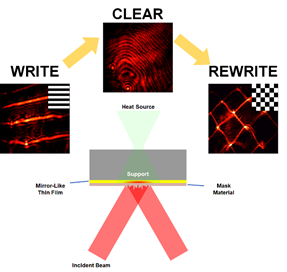
Invention Summary:
Current spatial light modulator (SLM) technology relies on either digital mirror arrays or liquid crystal reflective and transmittive cells. However, due to the upper bounds on the maximum light intensity of those systems, the applications of SLMs in fields where high intensity is required are limited.
Researchers at Rutgers University have developed dewetting-based SLMs which can cover all major laser wavelengths at similar pixel resolution and can work with high power laser source. The SLM in this invention comprises a mirror-like thin film and a layer of a mask material on top of the front surface. A heat source from the back of the thin film creates a height profile in the mask material through thermocapillary dewetting, enabling light modulation. This invention allows for the use of light sources with much higher intensity, which are not readily handled by conventional SLMs. In particular, it would add capabilities to existing systems by increasing their throughput and the complexity of the parts they could generate.
Advantages:
- Broad laser wavelength capability
- High laser source power
- Enabling a more adaptable version of an existing device
Market Applications:
- Direct laser metal sintering 3D printing
- Additive manufacturing
- Electronic devices
Intellectual Property & Development Status:
- Issued patent: US 10,884,253
- Available for licensing and/or research collaboration